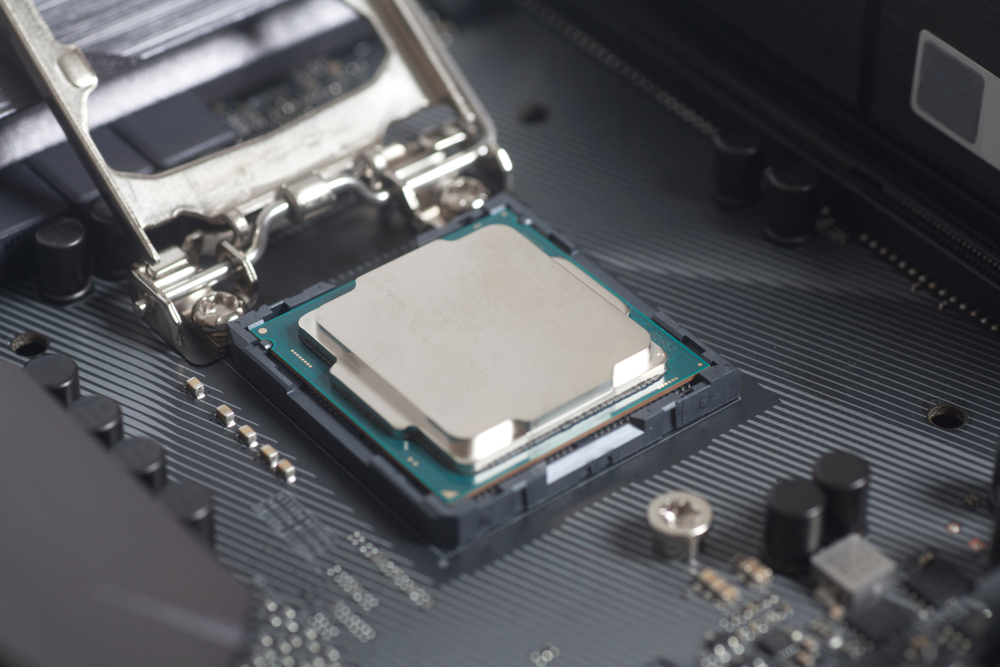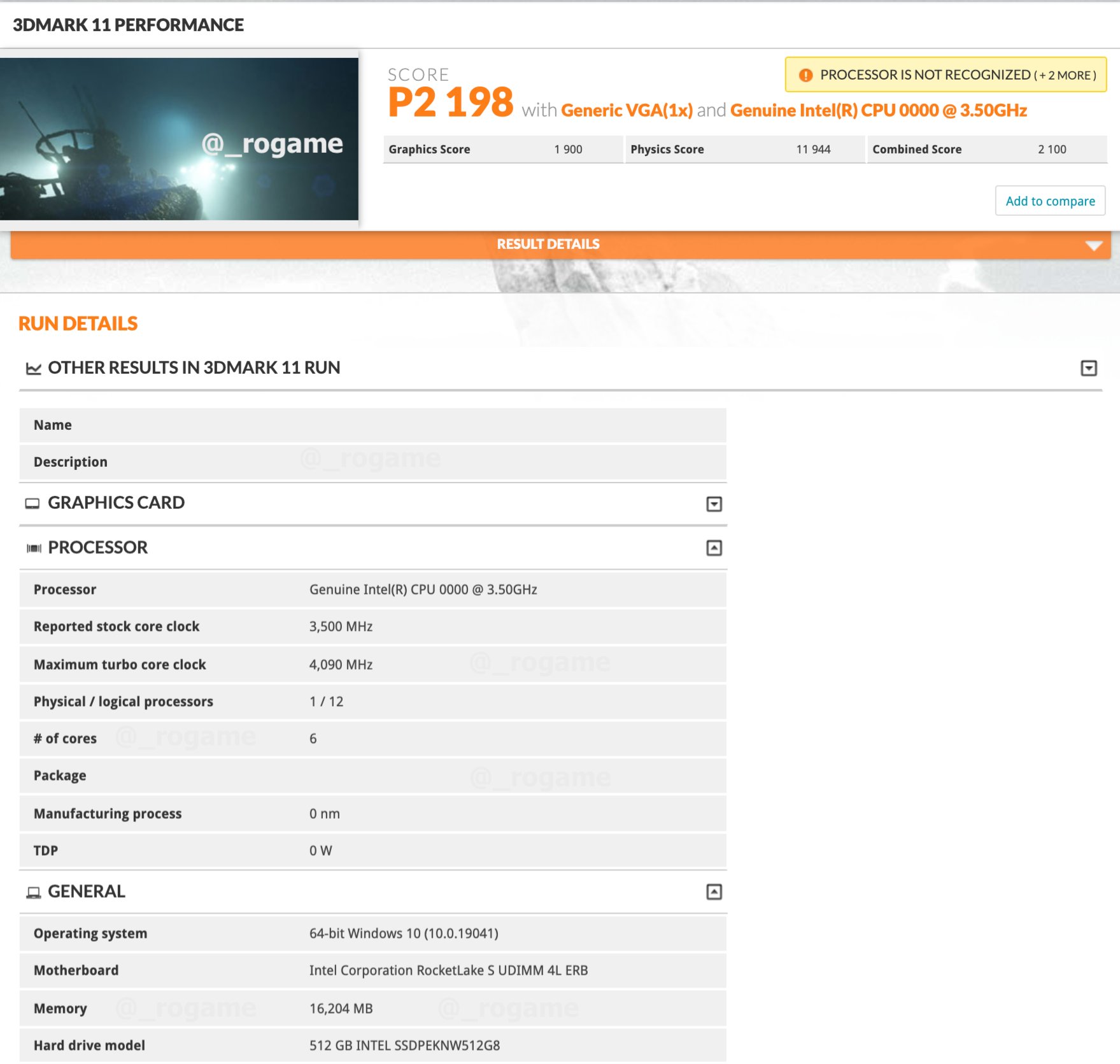Intel Rocket Lake Six-Core CPU Shows Off 4.2 GHz Boost Clock

Although Intel's 10th Generation Comet Lake-S CPUs have only just arrived, it appears that Intel's already fine-tuning Rocket Lake chips. Hardware detective @_rogame has reportedly discovered an early engineering sample (ES) of a six-core part.
Intel's 14nm process node has been around for a long time now. The last couple of generations of Intel processors were technically based on the same Skylake microarchitecture that debuted five years ago, (albeit with some changes here and there). If the rumors are accurate, Rocket Lake desktop CPUs should be the last chips using the aging process.
Rocket Lake is rumored to transition to the Willow Cove microarchitecture. For reference, Intel is also expected to use Willow Cove cores in its forthcoming Tiger Lake CPUs, which are expected to land in mobile chips preceding Rocket Lake. However, Tiger Lake should leverage the chipmaker's brand-new 10nm manufacturing process. Fortunately, Rocket Lake will probably slide into the recent LGA1200 socket, which Intel just introduced with Comet Lake.
It's also rumored that Intel is likely to stick with its Gen12 Xe integrated graphics for Rocket Lake. However, we haven't seen any early benchmarks corroborating the rumor. If true, Rocket Lake will be an interesting mix that combines 14nm CPU cores and 10nm graphics in a chiplet design. Above all, the biggest attraction that Rocket Lake has to offer is the long overdue support for the PCIe 4.0, an interface that AMD has already adopted on the majority of its CPUs.

Thus far, the six-core, 12-thread model surfaced with a 3.5 GHz base clock and 4.2 GHz boost clock. According to the hardware sleuth, there are multiple Rocket Lake submissions for 3DMark 11, but this particular one has the best score of them all.
For comparison, the tipster provided scores for the Core i5-10400 (codename Comet Lake) chip. The Core i5-10400 also conforms to a six-core, 12-thread design, making it the perfect comparison chip. The Core i5-10400 checks in with a 2.9 GHz base clock and 4.3 GHz boost clock.
The Rocket Lake processor scored 11,944 points in the physics test and 1,900 points in the graphics test. The Core i5-10400, on the other hand, put up scores of 12,828 points and 1,822 points in the physics and graphics tests, respectively. On the computing side, the Comet Lake chip seemingly delivers up to 7.4% higher performance than the Rocket Lake chip. In regards to integrated graphics, the Rocket Lake part is up to 4.3% faster. Given that it's an engineering sample, it might be too early to draw any concrete conclusions for Rocket Lake.
Get Tom's Hardware's best news and in-depth reviews, straight to your inbox.
The estimated time frame for Rocket Lake's launch is between Q4 of this year and the Q1 2021. Assuming that everything that we've known about Rocket Lake materializes, 400-series motherboard owners might finally have a processor that's able to exploit PCIe 4.0 -- a feature for which which they've already paid a premium.

Zhiye Liu is a news editor, memory reviewer, and SSD tester at Tom’s Hardware. Although he loves everything that’s hardware, he has a soft spot for CPUs, GPUs, and RAM.
-
mdd1963 Impressive that the same boost clock of the 6700K from 4 years ago has been achieved...again ;/Reply -
JarredWaltonGPU Reply
To be fair, it's a new architecture. Skylake had 300MHz lower clocks than Devil's Canyon but delivered about 15% more performance thanks to the architectural updates. It could be Intel will have some tweaks that make the lower clocks sensible -- the high-end Zen 2 CPUs still operate at all-core frequencies of around 4.2GHz as well.mdd1963 said:Impressive that the same boost clock of the 6700K from 4 years ago has been achieved...again ;/
The other option, which is possibly more likely, is that these ES chips are intentionally set to lower clocks. There could be 5.0GHz and higher retail models. Not sure if that will happen if the new architecture boosts IPC, though, as that would typically mean more transistors and more complexity, and sticking with 14nm Rocket Lake could be pretty toasty. -
InvalidError Reply
Since Comet Lake is barely getting to 5GHz stock boost and Willow Cove has two architectural generations worth of extra stuff crammed in its cores, I wouldn't expect Rocket Lake to get anywhere near 5GHz. For *Cove to reach 5GHz, Intel will need 10nm++(+) or 7nm.JarredWaltonGPU said:The other option, which is possibly more likely, is that these ES chips are intentionally set to lower clocks. There could be 5.0GHz and higher retail models. -
refillable Reply
I agree. Architectural upgrades had always brought bigger dies. Plus, backporting to 14nm is always going to be pose extra issues on die size, thermals, and power if cores and clocks stay the same. Don't expect anywhere above 10 cores, and 4.5 GHz boost. But since it's a new architecture, even the 8 core version can beat 10-core Comet Lake in multi-threaded performance if configured properly, so Intel did the best they could here.JarredWaltonGPU said:The other option, which is possibly more likely, is that these ES chips are intentionally set to lower clocks. There could be 5.0GHz and higher retail models. Not sure if that will happen if the new architecture boosts IPC, though, as that would typically mean more transistors and more complexity, and sticking with 14nm Rocket Lake could be pretty toasty.
AMD is also going for a 20% IPC uplift in the next gen. Competition is great. -
Deicidium369 ReplyJarredWaltonGPU said:To be fair, it's a new architecture. Skylake had 300MHz lower clocks than Devil's Canyon but delivered about 15% more performance thanks to the architectural updates. It could be Intel will have some tweaks that make the lower clocks sensible -- the high-end Zen 2 CPUs still operate at all-core frequencies of around 4.2GHz as well.
The other option, which is possibly more likely, is that these ES chips are intentionally set to lower clocks. There could be 5.0GHz and higher retail models. Not sure if that will happen if the new architecture boosts IPC, though, as that would typically mean more transistors and more complexity, and sticking with 14nm Rocket Lake could be pretty toasty.
Not expecting to see 5GHz clocks for quite a while if at all - 3.5GHz base will prob be 4-4.5GHz on the high spec product... can't see much more than that initially. -
Deicidium369 Reply
They have been saying they are increasing IPC with every gen - but yet still have no caught up yet. So take that 20% (more than likely fanboy sourced, not AMD) - it is from Another Marketing Deception after all.refillable said:I agree. Architectural upgrades had always brought bigger dies. Plus, backporting to 14nm is always going to be pose extra issues on die size, thermals, and power if cores and clocks stay the same. Don't expect anywhere above 10 cores, and 4.5 GHz boost. But since it's a new architecture, even the 8 core version can beat 10-core Comet Lake in multi-threaded performance if configured properly, so Intel did the best they could here.
AMD is also going for a 20% IPC uplift in the next gen. Competition is great.
8 cores on Rocket Lake S - and something around a 24EU Xe LP IGP. Clocks will be at least 4GHz base - and maybe a little later 4,5GHz.. -
InvalidError Reply
Just look at Ryzen 3300X vs 3100, AMD is getting ~15% higher performance in gaming simply from having a single-CCX layout. Zen 3 has single-CCX CCDs, so that may be the bulk of Zen 3's IPC gains right there.Deicidium369 said:They have been saying they are increasing IPC with every gen - but yet still have no caught up yet. So take that 20% (more than likely fanboy sourced, not AMD) - it is from Another Marketing Deception after all. -
refillable Reply
No. You don't have a clue. It's from Retired Engineer, who is connected with the most reliable industry sources from Taiwan. They have caught up pretty well especialy in non-latency sensitive workloads.Deicidium369 said:They have been saying they are increasing IPC with every gen - but yet still have no caught up yet. So take that 20% (more than likely fanboy sourced, not AMD) - it is from Another Marketing Deception after all. -
MasterMadBones Reply
AMD is currently in the lead with IPC on desktop and the advertised improvements have been pretty accurate since Zen. My only issue with the 20% is that it is the upper boundary of what is supposed to be somewhere between 15% and 20%. I prefer to use the lower boundary when talking about rumours.Deicidium369 said:They have been saying they are increasing IPC with every gen - but yet still have no caught up yet. So take that 20% (more than likely fanboy sourced, not AMD) - it is from Another Marketing Deception after all. -
InvalidError Reply
IPC is workload-dependent. AMD's IPC takes a nosedive whenever the workload involves significant communication between cores on different CCXes, which is why Intel is continue dominating gaming at least until Zen 3.MasterMadBones said:AMD is currently in the lead with IPC on desktop
I looked at some i10400 vs Ryzen 3600 reviews/benchmarks and the i5 looks surprisingly good for gaming and power-efficiency despite its 14nm-manyplusses handicap, only costs $20 more. Not much info on H470 motherboard pricing yet.